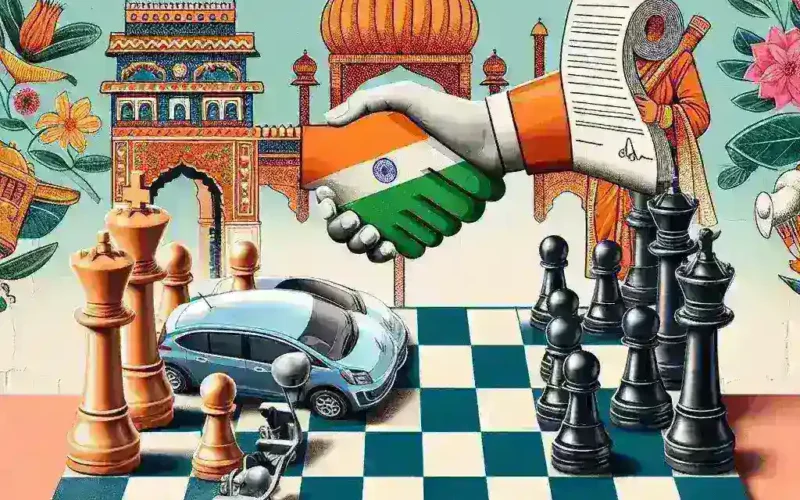India’s EV Tariff Cuts: A Strategic Gambit for US Trade Deal?
The whispers in the corridors of power are growing louder: India is reportedly considering significant cuts to its electric vehicle (EV) tariffs as a strategic manoeuvre to secure a comprehensive trade agreement with the United States. This move, if confirmed, would send ripples throughout the global automotive industry and reshape the geopolitical landscape of clean energy technology. This article delves into the multifaceted implications of this potential agreement, exploring the economic, political, and environmental ramifications for both nations.
The Current State of Play: A Complex Trade Relationship
The US-India trade relationship, while increasingly significant, is far from frictionless. Both countries are major economic players, but differing perspectives on trade practices, intellectual property rights, and market access have often created hurdles. The US has voiced concerns about India’s high tariffs on imported goods, including EVs, which American manufacturers claim hinder their access to the burgeoning Indian market. Conversely, India has expressed anxieties about certain US trade policies and non-tariff barriers.
Why the EV Tariff Cuts? A Calculated Risk
India’s potential tariff reduction on EVs isn’t a random act but a carefully calculated strategic move. The rationale is multifaceted:
- Access to US Technology and Investment: Lowering tariffs would encourage American EV manufacturers to invest more heavily in the Indian market. This would translate into advanced technology transfer, boosting India’s domestic EV industry and accelerating its transition to cleaner transportation.
- Boosting Domestic EV Production: The influx of US investment and technology could lead to increased domestic production of EVs in India, creating jobs and stimulating economic growth. This reduces reliance on imports and enhances India’s self-reliance in a strategically crucial sector.
- Strengthening Trade Relations: A significant concession like tariff reduction can pave the way for a broader, more balanced trade agreement with the US. This would foster enhanced cooperation on various economic fronts, benefiting both nations.
- Meeting Climate Goals: India is actively pursuing ambitious climate targets and needs to accelerate its EV adoption. The infusion of US technology and investment can aid this transition. The US, being a major player in the global clean energy transition, can provide crucial expertise and support.
Potential Benefits for Both Nations: A Win-Win Scenario?
The potential benefits of a mutually advantageous trade deal are substantial. For India, it’s about accelerating its EV revolution, attracting foreign investment, and improving its trade relations with a key global partner. For the US, it’s about expanding market access in a rapidly growing economy, promoting its own EV industry’s growth, and supporting its climate action goals.
However, Challenges Remain: Navigating Complexities
Despite the potential upsides, several challenges could hinder the success of this initiative. These include:
- Negotiating a Balanced Agreement: Reaching a trade agreement that satisfies both sides’ interests is a complex undertaking. It requires careful negotiation and compromise on various issues beyond EV tariffs.
- Concerns over Intellectual Property: India’s intellectual property laws have been a source of friction with the US. Addressing these concerns is critical for ensuring successful technology transfer and investment.
- Protecting Domestic Industries: India must carefully balance its efforts to attract foreign investment with protecting its domestic EV manufacturers from unfair competition.
- Geopolitical Considerations: The broader geopolitical context, including the ongoing competition between the US and China, will inevitably influence the trade negotiations. The deal’s success will also depend on the extent of cooperation from both nations’ respective governments.
Looking Ahead: A Speculative Outlook
The outcome of these negotiations remains uncertain. The success of this initiative hinges on several factors, including the political will of both governments, the ability to navigate complex trade issues, and the extent of cooperation between private sector stakeholders. However, a successful agreement holds the potential to be a significant step towards a more sustainable and interconnected global economy.
Conclusion: A Pivotal Moment in Clean Energy Diplomacy
India’s potential EV tariff cuts represent a pivotal moment in the global clean energy transition and US-India relations. While challenges remain, the potential benefits for both nations are substantial, underscoring the importance of securing a balanced and mutually advantageous trade agreement. The deal’s success will not only shape the future of the EV industry but also demonstrate the potential for international cooperation in addressing climate change and promoting sustainable economic growth. The coming months will be crucial in observing the unfolding progress of these negotiations and gauging their ultimate impact on the global stage.
Further Research: Exploring Key Data Points
To gain a deeper understanding of this topic, further research should focus on analyzing relevant data points such as:
- The current tariff rates on EVs in India and their impact on the market.
- The level of US investment in the Indian EV sector.
- The growth projections for the Indian EV market.
- The environmental impact of increased EV adoption in India.
- The potential implications for employment in both countries.
By studying these factors, we can gain a more nuanced perspective on the potential consequences of India’s proposed EV tariff cuts and the implications for the broader US-India trade relationship.

